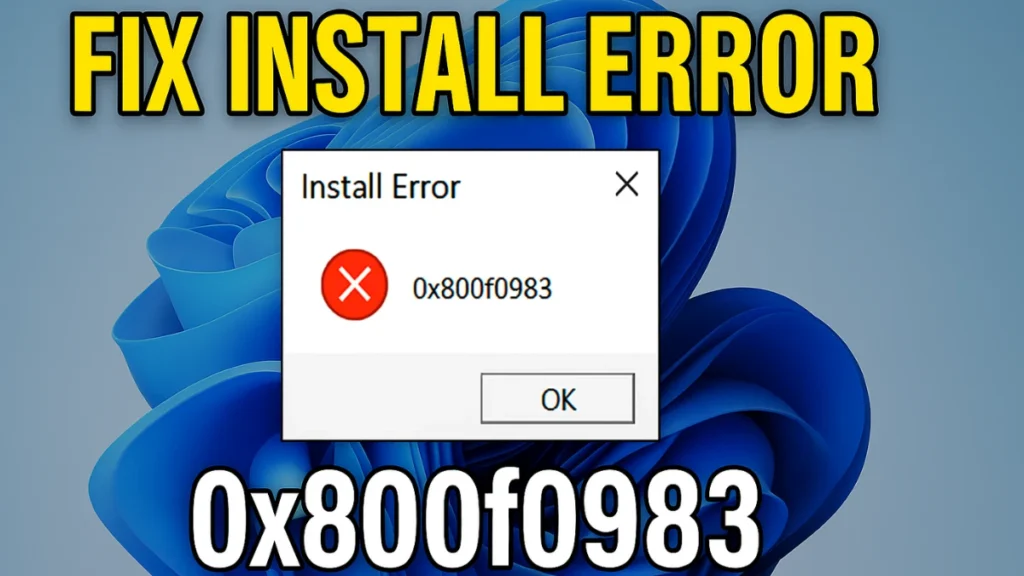If you’re trying to install a Windows 11 update and keep getting the error code 0x800f0983, you’re not alone. Many users have faced this problem—especially when installing large updates like KB5050009 or KB5050094. This error usually shows up when the update gets stuck at 10%, 17%, or even later, and it fails with this frustrating message.

What Does Error 0x800f0983 Mean?
The error code 0x800f0983 usually happens when there’s a problem with Windows system files or update components. It means the update process can’t find the correct files or folders it needs to finish the job. Sometimes this is caused by corrupted files, network issues, or leftover files from earlier updates.
Fix Install Error 0x800f0983 in Windows 11 (All Methods)
1. Run the Windows Update Troubleshooter
This tool is built into Windows and can fix many common update issues automatically.
Steps:
- Click Start, go to Settings → System → Troubleshoot → Other troubleshooters
- Find Windows Update and click Run
- Let it scan and fix any issues
- Restart your PC and try the update again
2. Run a System File Check (SFC)
SFC checks your system for missing or broken files and replaces them.
Steps:
- Search for Command Prompt, right-click it, and select Run as Administrator
- Type:
sfc /scannow - Press Enter
- Once it finishes, restart your PC
This can often fix the 0x800f0983 error, especially if system files were damaged.
3. Use the DISM Tool
If SFC didn’t work or the error keeps coming back, run DISM (Deployment Image Servicing and Management). This checks deeper system areas.
Steps:
- Open Command Prompt as administrator
- Type:
DISM /Online /Cleanup-Image /RestoreHealth- Press Enter and let it run. This may take some time
- Restart your PC after it’s done
If DISM gets stuck or doesn’t load, move to the next method.
4. Reset Windows Update Components
This method clears out old update files and resets the update system.
Steps:
- Open Command Prompt as administrator
- Enter these commands one by one (press Enter after each):
net stop wuauserv
net stop cryptSvc
net stop bits
net stop msiserver
ren C:\Windows\SoftwareDistribution SoftwareDistribution.old
ren C:\Windows\System32\catroot2 catroot2.old
net start wuauserv
net start cryptSvc
net start bits
net start msiserver- Close the Command Prompt and restart your computer
- Try updating again
5. Do a Repair Install from Settings (No Data Loss)
If the above steps didn’t work, don’t worry. Many users said this method fixed the problem completely.
Steps:
- Go to Settings → System → Recovery
- Under Fix problems using Windows Update, click Reinstall now
- Let Windows reinstall itself without deleting your files or apps
This method doesn’t erase anything—it just replaces the system files and keeps your data safe.
6. Use the Windows 11 ISO to Reinstall (In-Place Upgrade)
If the reinstall option from Settings doesn’t work, try doing an in-place upgrade manually.
Steps:
- Search Windows 11 ISO download in your browser
- Go to Microsoft’s official site and download the ISO file
- Mount the ISO (right-click → Mount)
- Open the folder and double-click setup.exe
- Follow the steps, and make sure you keep personal files and apps
- Click Install
This will reinstall Windows 11 over your current version and usually fixes the update error.
7. Check Internet Connection or Disable VPN
Slow or unstable internet can break the update process. If you’re using a VPN, disconnect it. Also:
- Restart your router
- Try connecting to a different network
- Then try the update again
8. Still Not Working? Try These Extras:
- Retry the update manually: Go to Windows Update, click Retry
- Clean boot your system: Boot with only essential services running to avoid software conflicts
- Check device drivers: Some users reported issues with faulty drivers causing this error—especially on AMD systems. Update your graphics or multimedia drivers if needed
Real User Feedback
- “Repair install fixed it for me—no data loss at all.”
- “Tried everything, only the ISO reinstall worked. Took time but it solved the problem.”
- “Even DISM was stuck, but after resetting Windows Update components, the update worked.”
Windows error 0x800f0983 can be frustrating, but it’s usually fixable without losing your data. Start with the simple tools like SFC and the Troubleshooter, then move to more advanced steps like the repair install or ISO method if needed.
Once fixed, your system should install future updates smoothly.
Need help with a specific update like KB5050009 or KB5043185? Feel free to ask in the comments.
Read More:
How to Activate SUN Bucks Card (Summer EBT)
How to Fix Error Code 224003: This Video File Cannot Be Played on Any Browser
Fix Error Code 232011: Resolve “This Video Cannot Be Played” Issue

